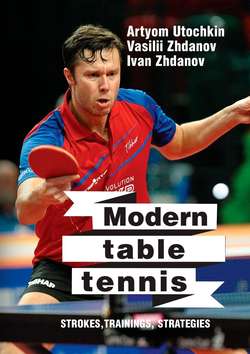Modern table tennis: strokes, trainings, strategies

Реклама. ООО «ЛитРес», ИНН: 7719571260.
Оглавление
Artyom Utochkin. Modern table tennis: strokes, trainings, strategies
A word from authors
Chapter 1. Modern table tennis
The prehistory of the forehand topspin, or how we came to a modern version of the stroke. History of the paradigm shift
The role of the backhand top-spin in modern table tennis. History of the paradigm shift
History of service changing in table tennis
Principles of organizing and training athletes in China – the world leader in table tennis
Chapter 2. Basic strokes of modern table tennis
Different variations of the forehand top-spin
Variation #1. Forehand top-spin against a simple ball or block
Variation #2. Powerful forehand top-spin
Variation #3. Chopped forehand top-spin
Variation #4. Counter-loop from the middle zone
Variation #5. Counter-loop on the right side of the table (in the near zone)
Variation #6. Forehand top-spin on the outflying ball
Variation #7. Forehand top-spin on the uprated ball
Variation #8. Forehand top-spin against semi-lob
Variation #9. Forehand top-spin with a stride (cross-movement)
Variation #10. Forehand top-spin with a jump
The role of the backhand top-spin in modern table tennis
Technique features of the modern backhand top-spin
Zones of backhand top-spin execution
Backhand top-spin in a near zone
Backhand top-spin in a semi-middle zone
Backhand top-spin in a middle zone
Serves
How to serve qualitatively
The criterion of a good serve #1 – spin
The criterion of a good serve #2 – length
The criterion of a good serve #3 – height
Modern serve position
Chapter 3. Training general physical fit in table tennis
12-minute Cooper test
Harvard step test
Flexibility test
Spring ability test
Training the stroke force
Auxiliary exercises to develop speed and power
Leg workout in today’s table tennis
How to properly move during the stroke?
Table tennis exercises to train movement skills
Complex exercises of table tennis to develop movement skills
Chapter 4. Psychological preparation
Motivation formation
Goal setting
Overcoming fear
Strong-willed preparation of the athlete
Changing motivation during workouts
Modern psychological approaches to training
Chapter 5. Strategy and tactics in today’s table tennis
Game strategy against the attacking, counterattacking, defensive style
Game strategy game against rapid and powerful playing style
The analysis of the game strategy of Ma Lin and Wang Hao
Game strategy by Ma Lin
Wang Hao game strategy
Tactics principles in table tennis
Bonus 1. How to create a super-couple in the doubles in table tennis?
Bonus 2. How to choose a ball in table tennis
Bonus 3. Selection of blade and rubber for different players
Bonus 4. Study of the strokes effectiveness
Отрывок из книги
Hello, dear reader! If you keep this book in your hands, then you are interested in table tennis, and especially you are interested in its modern state. In this book, we’ll talk about the development trends of this fascinating Olympic sport.
We promise that the journey to modern table tennis will be interesting for you, and most importantly, useful. We are sure that you will learn a lot from the pages of the book, in which we consider the basic strokes paradigm shift: the forehand topspin (loop), the backhand topspin and the serves. We will tell about different variations of strokes in detailed illustrations. You will become more aware of how to strike in a particular situation. Drawings are simple and understandable and you can easily repeat it at home. Let’s go deep into the psychological training of athletes in table tennis and touch on powerful and effective approaches that will be useful for a coach and an athlete.
.....
The scientific approach in training. Coaches use mathematical models in the training process, which simulates main rivals way of playing. In addition, a detailed video analysis, simulation analysis and knowledge about the opponent are implemented. All this adds confidence to athletes in a future game. Through the simulation, they are completely prepared psychologically, not only technically.
Creating competition inside the team. Two national teams are formed in China: the first and the second. On the one hand, of the first team players feel pressure, on the other hand, it motivates second team players to get into the first team. Thus, levels of both teams are growing through mutual competition.
.....